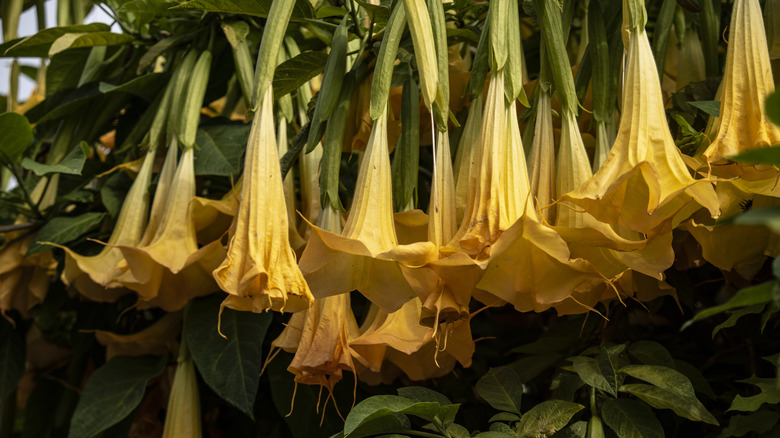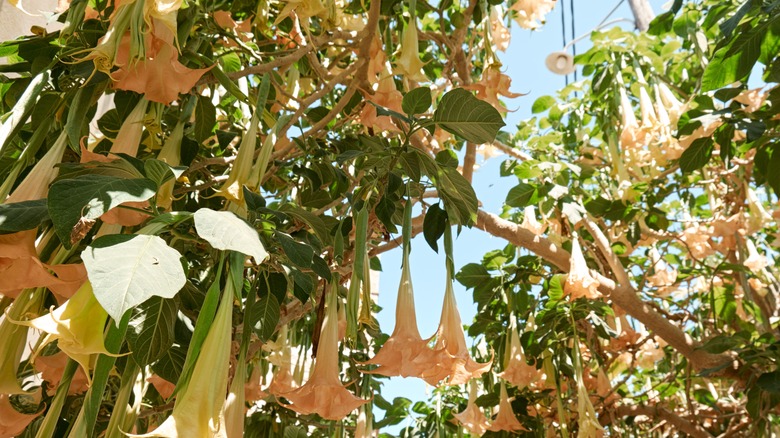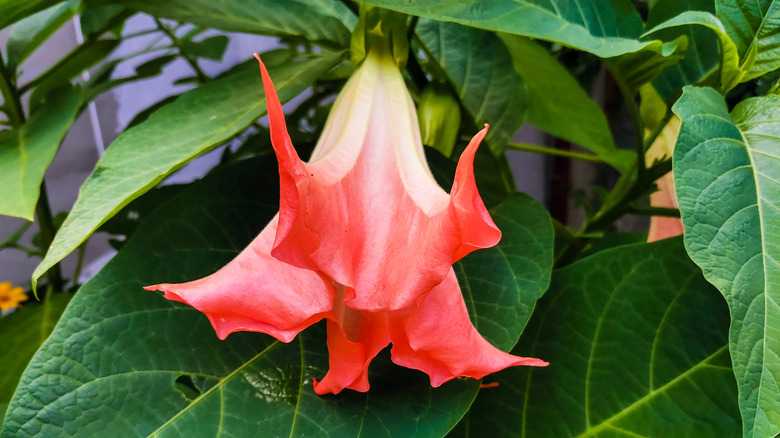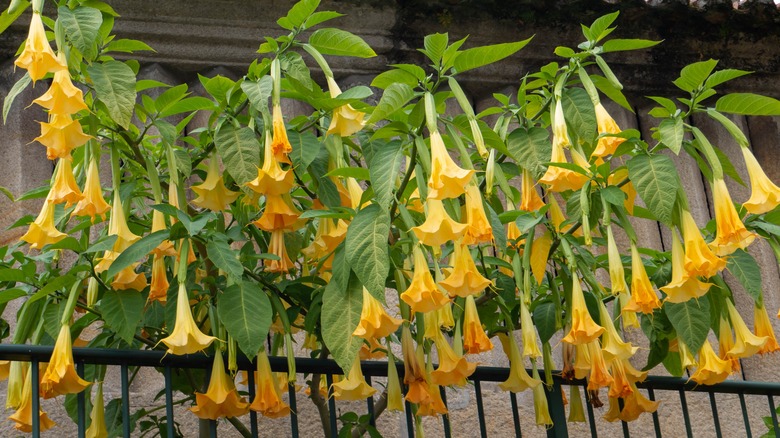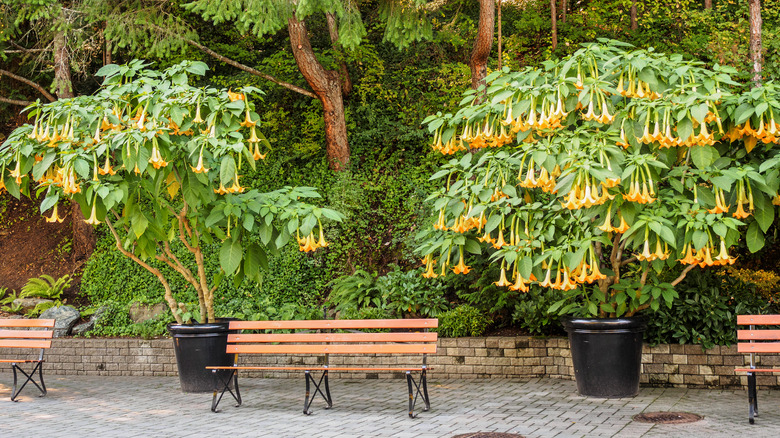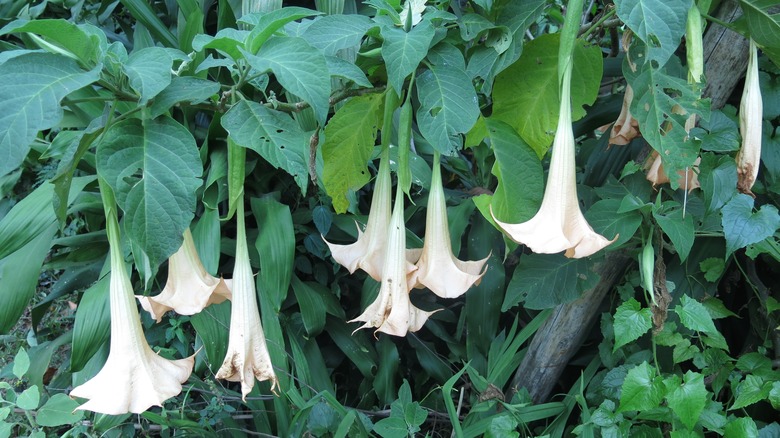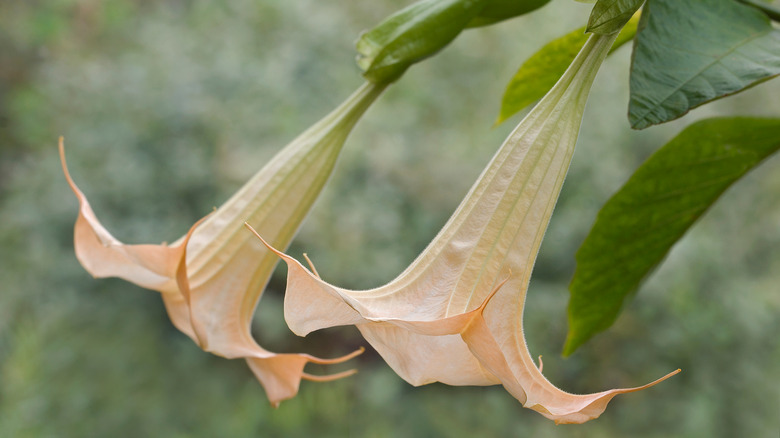How To Grow And Care For Angel's Trumpet
Angel's trumpet, or brugmansia, gets its name from its trumpet-shaped flowers that can grow up to 20 inches, according to The Spruce. This plant is native to Central and South America and is considered tropical and can be grown either as small trees or shrubs. Planting angel's trumpet can help create a dreamy, fantasy-like picture in your garden due to the wildlife they attract. They produce a strong smell that attracts hummingbirds and are pollinated by butterflies (via Gardening Know How). They come in various colors, including pink, peach, red, yellow, and white. They also have quite a few varieties and come in an array of shapes.
Brugmansia is an annual plant, meaning it will bloom beautifully in its growing season but die off completely during the winter and will not grow back the following season. They are also considered invasive in certain areas, such as Central America, the Pacific Islands, Australasia, and the Caribbean.
These beautiful, unique, and fragrant flowers are an excellent addition to any garden or outdoor space. Read on to learn more about how to plant and care for this plant.
How to use angel's trumpet in garden
When considering planting angel's trumpet in your garden, make sure you live in the correct hardiness zone. According to The Spruce, this plant grows best in USDA hardiness zones 7b to 10, including most of the West Coast and the Southern United States, and should not be exposed to temperatures lower than 40 degrees. If you live somewhere cooler, it is common to grow angel's trumpet in containers and bring them indoors when temperatures drop (via Gardener's Supply Center).
Angel's trumpets are also known to attract hummingbirds and butterflies. Consider planting or potting angel's trumpets near other plants or flowers that would benefit from butterfly pollination. On the flip side, ensure any surrounding plants won't be harmed by butterflies or hummingbirds. The attraction of these animals can add an enchanted, magical look to a backyard garden.
There are a few concerns to keep in mind regarding growing angel's trumpet. Most importantly, ensure angel's trumpets are not considered invasive where you live. Second, this plant is particularly susceptible to whiteflies. While this has preventions and remedies, ensure any surrounding plants won't be harmed by a potential infestation. Also, be sure you are planting with the angel trumpet's poisonous nature in mind, out of reach of children and animals.
How to grow angel's trumpet
There are a variety of ways to grow angel's trumpet. Visit your local garden center in their growing season and look for small nursery pots with angel's trumpets, likely in the annual section. These can be planted directly in the ground or maintained in a pot. You can also grow them from seed and propagation. Seeds can be purchased or harvested. Remove the fleshy outer layer if freshly harvested, or soak pre-purchased seeds for at least 24 hours before planting, suggested The Daily Gardener. Sew in a pot or directly in the ground by pressing the seeds into the soil, which you will need to keep moist and warm. Expect germination to take a couple of weeks to a month.
To propagate an existing plant, cut off an 8-inch limb, ensuring there are a few nodes along the stem. Nodes are the little notches where new leaves will grow. The Spruce recommends applying a rooting hormone to the cut end. Add the branch to a pot or hole in the ground and cover it with soil. Angel's trumpet will do fine in any soil, but ensure it's well-draining. The Spruce also recommends azalea or camellia soil mix for potted brugmansia. Water thoroughly. Keep the propagation steadily at 70 degrees. Consider creating a small greenhouse tent or rigging one with a metal collar and plastic until the plant is firmly rooted and grown.
How to care for angel's trumpet
Caring for angel's trumpet is a worthy endeavor. Proper care and maintenance will result in a beautiful tree with gorgeous, fragrant flowers. According to SFGate, angel's trumpet likes plenty of sun but doesn't want too many direct hot rays, warning that it may lose flowers if exposed to too much sun. Instead, ensure it has plenty of sun in the morning and shade from the afternoon sun. Do your best to make sure the plant is constantly moist but not waterlogged. If you're planting angel's trumpet in the ground, mulch around the base of the plant to help retain moisture.
The Daily Gardener recommends weekly fertilization, suggesting phosphate-rich, bloom-boosting fertilizer, such as a 10-50-10 or 15-30-15 liquid formula. Stop fertilizing when temperatures start to drop, just before overwintering. Prune when you want to shape up the angel's trumpet tree or shrub, ideally in the early spring, as well as pruning old branches to encourage new blooms.
To maintain the plant through the winter, move the plant indoors before the first frost, preferably somewhere with temperatures ranging from 30 to 45 degrees. Water intermittently.
How to repot angel's trumpet
Repotting angel's trumpet should be done every spring when it's brought out of dormancy, according to Gardener's Supply Center. Once there is no threat of frost, remove your plant from its current pot and break up the dirt to assess the root system. If there are any bad roots, remove them. Remove about 2 inches from the root system. Remove as much old soil as you can. Repot a size up (2 inches) until it reaches 20 gallons, says The Spruce.
Add a little bit of soil to the bottom of the pot to make up for the size change, then add your angel's trumpet. Fill with soil until it reaches just under the lip. Water thoroughly to expose air pockets, pack with more soil, and repeat until the plant is compactly potted. This plant will do well with any soil, but it should be well-draining. Consider adding sand to the soil to aid with this. Potted angel's trumpet will need more watering than in-ground plants, so ensure it isn't drying out.
Angel's trumpet varieties
According to The Daily Gardener, there are a handful of varieties of angel's trumpet. While they are all similar in appearance and care, they vary in size. However, no matter which type you choose to grow, they will still yield the same beauty. Here are just a few of those varieties:
- Brugmansia versicolor — This variety stuns with up to 2 feet long pink and orange flowers and is native to Ecuador.
- Brugmansia arborea — Originating from the Andes, this variety is one of the smaller brugmansia genus, the shrub's flowers only growing about 5 inches.
- Brugmansia aurea — This variety is also known as the golden angel's trumpet and is a listed endangered species.
- Brugmansia vulcanicola — Native to Columbia and Ecuador, this variety's flowers grow to be 9 inches long and are distinguished by the yellow flower with pink or red tips.
- Brugmansia insignis — This variety comes from Brazil, Bolivia, and Columbia and will only grow up to 13 feet, making it one of the smallest varieties of angel's trumpet.
Are angel's trumpet flowers toxic?
Angel's trumpets are extremely toxic. According to SFGate, the entire plant is toxic. The plant contains various chemicals that are used in modern medicines but are highly poisonous when ingested. Even touching the plant can result in irritation, so take care to wear gloves when handling the plant and wash your hands thoroughly afterward. SFGate also warns that the most common way people are exposed to angel's trumpet poisoning is by rubbing their eyes after handling the plant, which will result in symptoms ranging from muscle weakness, fever, hallucinations, or a quickened pulse, to seizures, paralysis, becoming comatose, and even death. Consider wearing protective eyewear when tending to the plant, as well.
The plant is often consumed due to its hallucinogenic properties, says Discovery. This should be avoided at all costs, as the hallucinations are short-lived and often more terrifying than popular hallucinogenic drugs and have a high probability of death.
Angel's trumpet is equally toxic to animals. According to Wag, symptoms of angel's trumpet poisoning can include loss of appetite, your pet seeming confused or behaving oddly, pupil dilation, vomiting, increased heart rate, constipation, loss of mobility, paralysis, seizures, and death. Call your vet immediately if you suspect your pet has ingested angel's trumpet. If you catch your pet eating the plant, bring the piece with you, as it will help the vet determine how to care for your fluffy friend.
